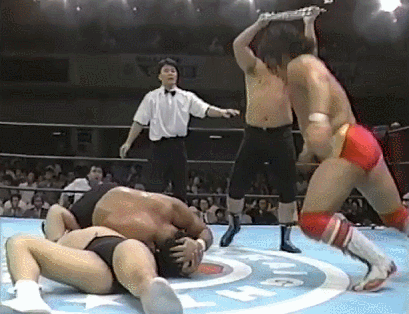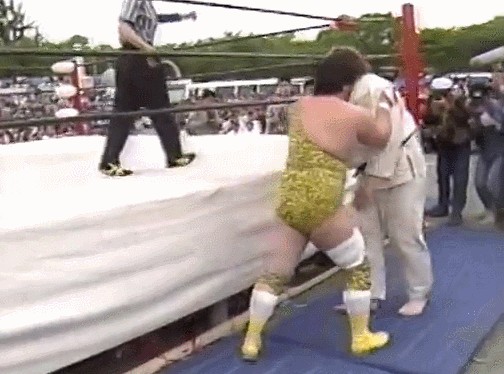Again, simpler is better.
Tenryu and Yatsu have another one of their build up tags, once again lasting less than fifteen minutes (under twelve minutes this time), featuring no real large developments and clearly not aiming for the stars exactly, and it winds up, once more, being great less because of any conscious effort, and more because four great wrestlers are having it.
No match is ever entirely the same, and of course, there are differences.
Firstly, the pace is a lot faster.
Nobody is ever really taken down and cut off one one side of the ring long term in a way that other big SWS tags have shown. Tenryu and Nakano both get beaten up for a few minutes each, but everything moves so fast that to call any tag in this a hot tag would be a mistake. It’s not always the sort of thing I love, as few things in wrestling are as thrilling as a well done hot tag and a pace like this denies that, but wrestlers like these manage to preserve the intensity and fire along with the pace, so it never loses the overall frantic feeling. It’s not my favorite thing, but in a shorter match with wrestlers like these who are very good at never blowing up that more genuine feeling and spirit, it still works really really well.
Secondly, our two leads get into it a lot more here than they have in their other SWS tags against each other so far, and it’s a big part of why the performances are again responsible for elevating a match without such lofty ambitions.
There is no finishing run stuff to speak of, nor are they exactly giving the game away in terms of the content of the eventual singles meeting, but there i more of it now, at the exact right time to finally deliver more of it. They’ve lost roughly zero percent of the chemistry that they had together for most of the previous six years, and both as a result of that and how it’s been teased out and rarely delivered upon over the previous nine months, the Tenryu and Yatsu sections in this are especially electric.
Haku and George Takano are also both fantastic.
George is the perfect combination of the sort of underdog that Yatsu needs and also the kind of wrestler who can beat ass against two bigger guys, with neither function seeming at all out of place. Haku is a brilliant foil and backup, and for all the expected joy that there is in he and Tenryu wailing on each other with chops or him breaking out some less common offense like a huge leaping sidekick off the ropes, it’s also real fun to see him cheat more and get dirty in a way he often didn’t in America. Like the other great SWS tags, each of the two supporting players has great chemistry with the leader on the other side too, guaranteeing that zero percent of this match suffers as a result of any weaker combinations.
Every moment of it is great.
They also, again, nail the larger parts of the thing, the narrative work and the build to Tenryu and Yatsu eventually finally getting at each other. This time, rather than Yatsu snap, it’s Tenryu who loses it at the end, losing focus after yet another cheap shot to Takano and going after Haku exclusively on the floor, both with a chair and simply with his hands. It’s not only enough to matter, but in a match that had seen so so so many nearfall saves from both sides and every man in the match, it’s a classically great ending idea built up real well in the match itself.
Left alone, Yatsu is just better enough than Takano for it to matter. He has a hard time immediately putting our favorite to rest despite the cheap shot of Haku setting him up, but after a flicker of a comeback, evil Yatsu blocks something into a cradle to just barely eek it out while the big hero is a little too distracted by beating the ass of his henchman.
To repeat, even if it is not as great as the match two weeks prior, this is the sort of wrestling that I turn the matches on to see.
Villains transgressing and our heroes beating the shit out of them for it, the delay once more of the payoff while still moving things forward enough to satisfy, violence, energy, an unbelievable respect for my time, and a victory for the bad guys that walks a line perfectly between a little luck, a little bullshit, and enough strategic design to be both impressive and upsetting. Real pro wrestling stuff.
One of the bigger secrets of 1991 so far, less because it is among the year’s best or anything like that, and far more because it is so much fun and I have never once heard or read a word about it elsewhere.



